Search the Special Collections and Archives Portal
Search Results
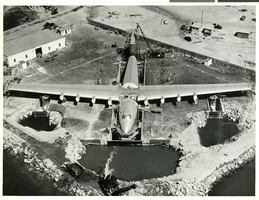
Aerial photograph of Hughes' flying boat, Los Angeles (Calif.), July 16, 1947
Date
1947-07-16
Archival Collection
Description
Howard Hughes' flying boat docked near the waters of Los Angeles Harbor, taken July 16, 1947.
Image
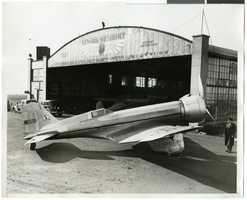
Photograph of Howard Hughes' Northrop Gamma Racer in Newark, New Jersey, January 14, 1936
Date
1936-01-04
Archival Collection
Description
A view of the side of Howard Hughes' Northrop Gamma Racer.
Image
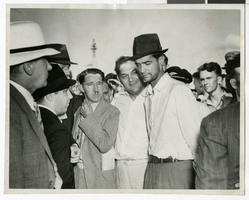
Photograph of Howard Hughes after arriving in Minneapolis, Minnesota, July 14, 1938
Date
1938-07-14
Archival Collection
Description
The black and white view of Howard Hughes in Minneapolis, Minnesota. Description written on back of photograph: "July 14, 1938: Tired and bearded, Howard Hughes was surrounded as he left his plane at the municipal airport (World-Chamberlain Field) to secure weather information before leaving Minneapolis to complete his record-breaking around-the-world flight-- the fastest flight ever made in circumnavigating the globe. Photo-courtesy "The Minneapolis Star" Board of Park Commissions 325 City Hall Minneapolis, Minn."
Image
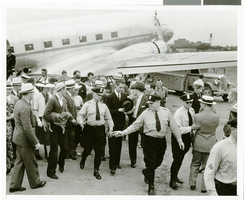
Photograph of Howard Hughes and Cordell Hull, Washington D.C., July 21, 1938
Date
1938-07-21
Archival Collection
Description
Typed onto a piece of paper attached to the image: "As Hughes Visited Washington To Thank Cordell Hull, Washing, D. C. -- Police escorting Howard Hughes holding hat, through the admiring throungs at the Washington Airport as the intrepid flyer and his four companions on his Round-The-World flight came to the Capital, July 21st, to personally thank Secretary of State Cordell Hull for his cooperation in clearing their take-offs on their flight. Credit Line (ACME) 7/21/38."
Image
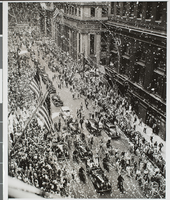
Photograph of a parade for Howard Hughes, Chicago, July 30, 1938
Date
1938-07-30
Archival Collection
Description
Typed onto a piece of paper attached to the image: "Hughes and Flyers Welcomed to Chicago - A view of the parade staged in honor of Howard Hughes and his four companions passing down La Salle Street, Chicago, in a shower of ticker-tape and paper. The flyers, who circled the globe in 3 days and 19 hours, are in the first three autos. Credit Lines (ACME) 7/30/38 (NY)."
Image
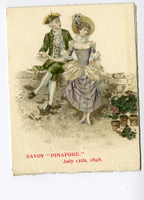
Savoy, menu, July 12, 1898
Date
1898-07-12
Archival Collection
Description
Note: It is possible that the word "Pinafore" mentioned on the cover of the menu refers to the well known Gibert and Sullivan comic opera called H.M.S. Pinafore. It was written in 1878. In 1899 this opera was revived at the Savoy Theater. It is assumed that this menu is from or the Savoy Hotel which was built next to the Savoy Theater Menu insert: Poems Restaurant: Savoy Hotel & Restaurant Location: London, England
Text
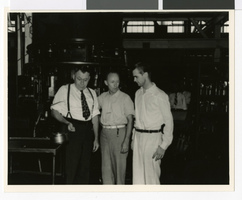
Photograph of Howard Hughes and two men, Houston, Texas, July 30, 1938
Date
1938-07-30
Archival Collection
Description
Howard Hughes (rt.)with two other unidentified men inside the Hughes Tool Co. factory in Houston.
Image
Hughes Aviation gift shop, 1974 July 23
Level of Description
File
Archival Collection
Frank Mitrani Photographs
To request this item in person:
Collection Number: PH-00332
Collection Name: Frank Mitrani Photographs
Box/Folder: Box 24
Collection Name: Frank Mitrani Photographs
Box/Folder: Box 24
Archival Component
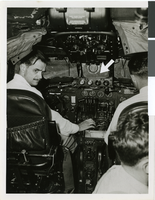
Photographs for press release, Hughes demonstrates new radar warning, May 1, 1947
Date
1947-05-01
Archival Collection
Description
Photographs that accompany the attached press release: "HUGHES DEMONSTRATES NEW RADAR WARNING Howard Hughes, at the controls of the TWA Constellation, demonstrates the efficiency of his new radar safety device, which is being installed on all TWA planes and which will be available to all other airlines in the United States as soon as he can produce the equipment. The instrument warns the pilot by a brilliant red light and a warning horn the instant the plane comes too close to the ground, or any building, bridge, mountain, aircraft or other obstacle, regardless of darkness or weather conditions. The device weighs only 16 pounds and costs about $130. (Arrow points to warning lights on instrument panel). Center photo shows the Hughes-piloted Constellation approaching a mountain in Southern California's Santa Monica Range, an area usually voided by pilots because of its dangerous peaks. This particular plane's radar set was equipped with both 500-feet and 2,000-feet warning signals. The 500-feet warning range now being installed on TWA airliners was developed first because the greatest immediate need for it is during approaches and landings. The 2,000-feet warning is designed from enroute flying to guarantee clearance of mountains and other obstacles. Photo at right shows the Constellation veering to the left and climbing at a speed of 300 miles an hour after receiving radar warning of an obstacle in its flight path."
Image
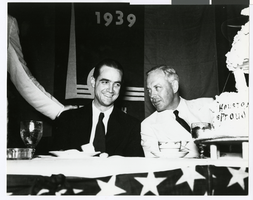
Photograph of Howard Hughes and Noah Dietrich, Houston, Texas, July 30, 1939
Date
1938-07-30
Archival Collection
Description
Howard Hughes (left) Noah Dietrich at a Hughes Tool Company celebration in Houston, Texas in 1939.
Image
Pagination
Refine my results
Content Type
Creator or Contributor
Subject
Archival Collection
Digital Project
Resource Type
Year
Material Type
Place
Language
Records Classification
